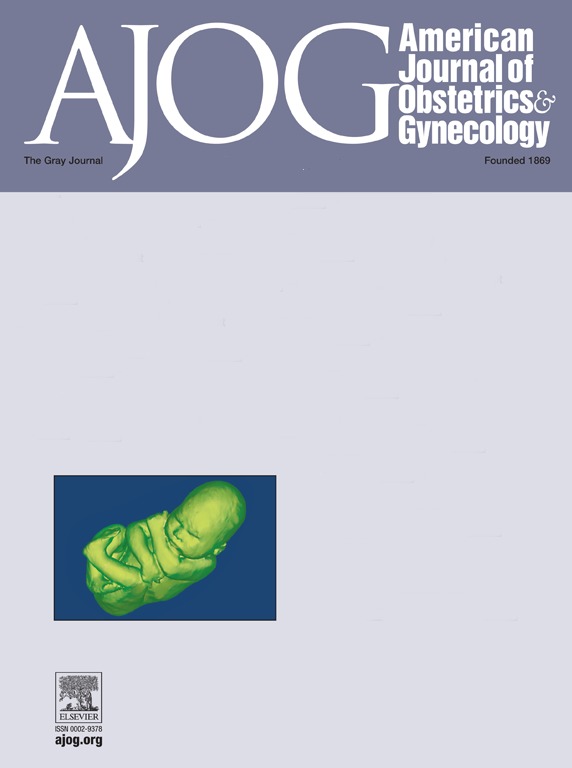低冲击腹腔镜子宫切除术后恢复:一项随机对照临床试验。
IF 8.4
1区 医学
Q1 OBSTETRICS & GYNECOLOGY
引用次数: 0
摘要
背景:低冲击腹腔镜手术(LIL)是一种使用微型腹腔镜器械和低且稳定的气腹压力的手术方案,是一种微创方法,可以减轻腹腔镜手术对局部和全身的影响。然而,其真正的临床影响仍然缺乏文献记载。目的比较腹腔镜子宫切除术后6小时(即术后6H) LIL对术后恢复质量的影响。研究设计:单中心、双盲、随机对照试验,于2019年12月至2023年8月进行,评估门诊腹腔镜子宫切除术的不同方法。本研究纳入68例门诊腹腔镜子宫切除术的成年患者,随机分为两组:使用微型套管针和低腹膜压力的LIL组和使用标准尺寸套管针和较高腹膜充气压力的常规腹腔镜组。主要终点是术后6H的恢复质量,采用多维术后恢复质量量表(PQRS)进行评估。次要结果为:镇痛伤害感觉指数引导的术中瑞芬太尼给药、术中疼痛刺激、术后疼痛强度、阿片类药物使用、外科医生评估的手术条件、不良事件、出院时间和患者满意度。结果得到两个同质组。6例lil组患者由于手术困难需要更大的器械和更高的气腹压力来完成干预而出现方案偏差。术后6H恢复质量LIL组与常规组相当(分别有10/34(29%)和8/34(24%)患者恢复术前PQRS值,p=0.58)。LIL组术中疼痛刺激较低,瑞芬太尼用量较少。术后休息和咳嗽疼痛强度、吗啡需氧量、不良事件、当日出院率和患者满意度在两组间无差异。LIL组的手术条件较差。结论:尽管术中疼痛刺激略少,证明了其微创性,但与常规腹腔镜相比,LIL并没有改善术后6h的恢复。LIL组的手术条件较差。LIL似乎没有提供任何临床益处。本文章由计算机程序翻译,如有差异,请以英文原文为准。
Recovery after Low-Impact Laparoscopic Hysterectomy: A Randomized Controlled Clinical Trial.
BACKGROUND
Low-impact laparoscopy (LIL), a surgical protocol using mini-laparoscopic instruments and low-and-stable pneumoperitoneal pressure, was developed as a minimally invasive approach to mitigate local and systemic effects of laparoscopy. However, its real clinical impact is still poorly documented.
OBJECTIVE
To evaluate LIL impact on the postoperative recovery quality 6 hours after laparoscopic hysterectomy (henceforth 6H postsurgery) compared to conventional laparoscopy.
STUDY DESIGN
Single-center, double-blinded, randomized controlled trial, conducted between December 2019 and August 2023, evaluating different approaches for outpatient laparoscopic hysterectomies. Sixty-eight adult patients scheduled for outpatient laparoscopic hysterectomy were included and randomized into 2 groups: LIL with mini-trocars and low peritoneal pressure or conventional laparoscopy with standard-size trocars and higher peritoneal insufflation pressure. The primary outcome was recovery quality 6H postsurgery, assessed with the multidimensional Postoperative Quality of Recovery Scale (PQRS). Secondary outcomes were: Analgesia Nociception Index-guided intraoperative remifentanil administration, intraoperative pain stimulation, postoperative pain intensity, opioid use, surgeon-assessed surgical conditions, adverse events, time to discharge and patient satisfaction.
RESULTS
Two homogeneous groups were obtained. Protocol deviations attributable to surgical difficulties requiring larger instruments and higher pneumoperitoneal pressures to complete the intervention occurred in 6 LIL-group patients. Recovery quality 6H postsurgery was comparable for the LIL and conventional groups (respectively, 10/34 (29%) and 8/34 (24%) of patients recovered their preoperative PQRS values, p=0.58). The LIL group had lower intraoperative pain stimulation, with less remifentanil consumption. Postoperative pain intensity at rest and coughing, and morphine-requirement, adverse event, same-day-discharge and patient-satisfaction rates did not differ between the 2 groups. Surgical conditions were deemed poorer in the LIL group.
CONCLUSION
Despite slightly less intraoperative pain stimulation, attesting to its minimally invasive nature, LIL did not appear to improve 6H-postsurgery recovery compared to conventional laparoscopy. Surgical conditions were rated poorer for the LIL group. LIL does not seem to provide any clinical benefit.
求助全文
通过发布文献求助,成功后即可免费获取论文全文。
去求助
来源期刊
CiteScore
15.90
自引率
7.10%
发文量
2237
审稿时长
47 days
期刊介绍:
The American Journal of Obstetrics and Gynecology, known as "The Gray Journal," covers the entire spectrum of Obstetrics and Gynecology. It aims to publish original research (clinical and translational), reviews, opinions, video clips, podcasts, and interviews that contribute to understanding health and disease and have the potential to impact the practice of women's healthcare.
Focus Areas:
Diagnosis, Treatment, Prediction, and Prevention: The journal focuses on research related to the diagnosis, treatment, prediction, and prevention of obstetrical and gynecological disorders.
Biology of Reproduction: AJOG publishes work on the biology of reproduction, including studies on reproductive physiology and mechanisms of obstetrical and gynecological diseases.
Content Types:
Original Research: Clinical and translational research articles.
Reviews: Comprehensive reviews providing insights into various aspects of obstetrics and gynecology.
Opinions: Perspectives and opinions on important topics in the field.
Multimedia Content: Video clips, podcasts, and interviews.
Peer Review Process:
All submissions undergo a rigorous peer review process to ensure quality and relevance to the field of obstetrics and gynecology.

 求助内容:
求助内容: 应助结果提醒方式:
应助结果提醒方式:


